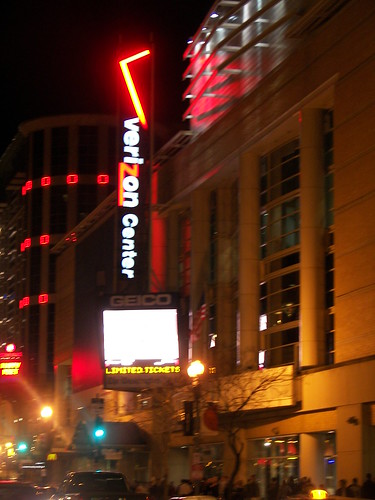Madison Square Garden vs. the Verizon Center on a key urban measure

The Capitals' Donald Brashear and Rangers' Colton Orr engage in fisticuffs during the first period. Photo Credit: By Pablo Martinez Monsivais -- Associated Press Photo
Yes, I am tired of how everyone believes that the Verizon Center saved downtown... Lately I have been thinking it would be interesting to do intercept surveys of the people walking on 7th Street--after all, since the events there are at 7 pm, and there are many nights when there aren't events, where do the people come from and go? Uhh, not the Verizon Center.
Again, this is about layering, there being multiple activities/destinations on the street, including retail, culture, restaurants, museums, transit, etc. Certainly, the fact that there are now a few thousand residents living within a couple blocks makes a big difference too.
Plus, the reason that the "East End" "developed" is because there was little land to the west that could be developed (i.e., building an office tower over the Hecht's department store).
Once DC became more politically and economically stable (post 1997), the climate for investment improved.
Plus, because of the height restriction, there is always a fair amount of demand for office space close to the federal core for law firms, associations, and other businesses that need close proximity to the federal government to be able to influence and benefit from it.
Anyway, Streetsblog has an interesting entry about the New York Rangers hockey team vs. the New York Knicks basketball team, "Unlike the Knicks, “New York’s Team” Takes the Subway to Work."
Seems that many of the hockey players take the subway to work, while the basketball players drive.
I imagine that most of the athletes going to the Verizon Center drive, whether they play hockey or basketball. I wonder how many of the hockey and basketball (and baseball) players live in the city? After all, the city can't tax the income of the "Washington" players unless they live in the city. I imagine most don't. Here's another way the city proper subsidizes the suburbs.

I am not much interested in professional sports (except for the business and culture aspects) but if I were to pick a hockey team to favor, maybe from the standpoint of urban economics, public finance, and urban design and placemaking, it would have to be the New York Rangers.
Not to mention the fact that the sports events are deliberately scheduled at the Verizon Center in a manner that almost forces attendees to not spend money outside of the arena, but to go directly to the arena, and spend all their money inside, to be sure they don't miss the game.
During the week, games are scheduled at 7pm, which doesn't allow much time to eat after work, before getting to the game.
So the economic multiplier effect outside of the arena is pretty limited, except on weekends.
But the multiplier effect is the whole justification for public financing of teams and arenas.
Labels: sports and economic development, urban design/placemaking



0 Comments:
Post a Comment
<< Home